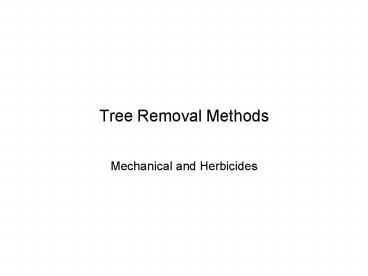Tree Removal Methods - PowerPoint PPT Presentation
1 / 25
Title:
Tree Removal Methods
Description:
Not always practical if large numbers of trees must be removed. Can ... Hack and squirt. Hypo hatchet. Avoid use in early spring, sap flow blocks absorption ... – PowerPoint PPT presentation
Number of Views:167
Avg rating:3.0/5.0
Title: Tree Removal Methods
1
Tree Removal Methods
- Mechanical and Herbicides
2
Mechanical
- Felling
- Not always practical if large numbers of trees
must be removed - Can damage residual trees
- Brush saw for small stems, brush
3
Mechanical
- Girdling
- Double girdle 1 in. deep spaced 6 in. apart
- Later winter, early spring during sap rise
- Diffuse porous species are poor candidates unless
herbicide is used
4
Mechanical
- Mechanized removal
- Brush Hog
- Small trees and brush
5
Mechanical
- Mechanized removal
- Tracked feller buncher
- Rotating cab with hinged arm
- Steep, uneven terrain
- Hydrostatic feller buncher
- Easily maneuverable
- Plantations
- 3-wheeled feller buncher
- Lightweight
- Flat terrain
6
Herbicides
- Why herbicide?
- Site preparation
- Woody release
- Herbaceous release
- Mid-rotation release
- Right-of-way maintenance
7
Herbicides
- Possible impacts
- Can cause damage to crop trees
- Mechanical methods also damage trees!
- Flashback herbicide released by a targeted tree
becomes available for uptake by another - Non-target organisms
- Soil and water quality
8
Herbicides
- What is needed
- Carrier (water or oil)
- Herbicide
- Adjuvant (increases effectiveness)
- Surfactants
- Buffers
- Ammonium salts
9
Types of Herbicides
- Imazapyr
- Chopper - BASF Ester formulation
- Arsenal AC -BASF Amine formulation
- Release pine from hardwoods
- Imidazolinone family
- Inhibits branched amino acid synthesis
- Glyphosate
- Roundup (not registered for forestry) - Monsanto
- Accord DowAgro
- Release pine from hardwoods
- Rodeo Monsanto (aquatic label)
- Various generics
- Family of its own
- Inhibits aromatic amino acid synthesis
10
Types of Herbicides
- Triclopyr - DowAgro
- Garlon 4 DowAgro Ester
- Release pine from hardwoods
- Garlon 3A DowAgro Amine
- Release pine from hardwoods
- Pyridinecarboxylic acid family
- Behaves like auxin (IAA)
- Over stimulates cell metabolism
11
Types of Herbicides
- Hexazinone - DuPont
- Velpar L Liquid
- Release pine from hardwoods
- Velpar ULW Granule
- Release pine from hardwoods
- Oustar ( sulfometuron) Soluble granules
- Triazine family
- Inhibits photosynthesis by blocking electron
transport which leads to lipid peroxidation and
cellular disintegration
12
Types of Herbicides
- Sulfometuron - DuPont
- Oust XP
- Sulfonylurea family
- Inhibits branched amino acid synthesis
- Metsulfuron - DuPont
- Escort XP
- Release pine from hardwoods
- Sulfonylurea family
- Inhibits branched amino acid synthesis
13
Types of Herbicides
- Clopyralid
- Transline DowAgro
- Pyridinecarboxylic acid family
- Behaves like auxin (IAA)
- Over stimulates cell metabolism
- Effective only on composites and legumes
- 2,4-D
- Various brands (read the label)
- Phenoxyacetic acid family
- Behaves like auxin (IAA)
- Over stimulates cell metabolism
14
Types of Herbicides
- Picloram
- Tordon - Dow-Agro
- Various formulations
- Pyridinecarboxylic acid family
- Behaves like auxin (IAA)
- Over stimulates cell metabolism
- Long Residual
15
Herbicides
- Surfactants
- Entry II (ethoxylated tallow amine)
- Original Surfactant in Roundup
- Excellent safety on pine
- Cannot penetrate the cuticle of pine but can
hardwood - Used for Release
- Timbersurf 90
- NU-FILM-IR
- Sun-it II (methoxylated sunflower oil)
16
Herbicides
- Aerial/mechanized applications
- Large stands of invasives
- Hardwoods in pine plantations
- Site preparation
- Type/quantity used varies with target species
- Ex. 12 fl. oz. Arsenal AC 1.6 fl. oz.
surfactant in water 5 GPA for aerial conifer
release treatment
17
Herbicides
- Backpack applicators
- Foliar spray
- Glyphosate at 2-4 solution based on target
species - Basal bark application
- Soak lower stem and root collar
- Dye increases accuracy of application
- Most effective on stems lt 6 in. DBH
- 25 Garlon 4 solution in diesel fuel
18
Herbicides
- Cut surface methods
- Hack and squirt
- Hypo hatchet
- Avoid use in early spring, sap flow blocks
absorption - Garlon 3A or Roundup Pro in complete ax frill
(pure solution or 50 dilution
19
Herbicides
- Cut surface methods
- Basal tree injectors
- ½ mL of Garlon 3A at each injector site, 2-3
between wounds - Avoid use during early spring
20
Herbicide
- Cut surface methods
- Cut stump application
- Prevents stump sprouting
- For small stems treat entire stump, gt 3 outer
edge is sufficient - 20 glyphosate solution
21
Herbicide
- Granular herbicides
- Soil active, enter through root systems
- Some prevent germination
- Site prep, conifer management
- Aerial or ground applications
- Gridballs
- Large pellet
- Distributed on predetermined grid system
- Brush and undesirable species control
- Plantations
22
Pruning
- Branches should be pruned as close to the trunk
as possible without damaging the branch collar
and branch bark ridge.
23
Pruning
- Improper technique
- Flush cuts
- Damage stem tissue
- Poor woundwood coverage
- Branch stubs
- Woundwood must cover entire stub
- Slow to heal
- Entry for pathogens
24
Pruning
- Pruning large branches
- 3 cuts
- 1. shallow notch on underside of branch
- 2. remove branch outside of first cut
- 3. remove remaining stub outside of branch
collar/branch bark ridge - Prevents bark ripping damage
25
Pruning
- Always prune live branches during the dormant
season - Maximize wound closure
- Reduce chance of transmitting disease
- Discourage excessive sap flow from wounds
- Dead branches may be pruned any time of year































